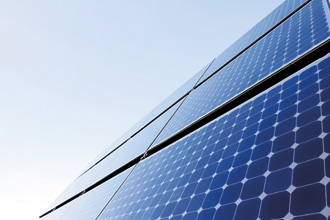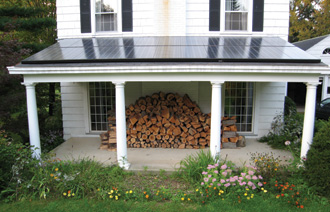Oberlin Alumni Magazine
Spring 2007 Vol. 102 No. 4
Positive Energy

 With the summer months approaching, the McDaniels’ nine-month old photovoltaic system, installed on the roof of their south-facing porch in Troy N.Y., is on track to generate more electricity than the home needs in a year. While the roof will recover its financial cost in about 10 years, the environmental benefits are much greater: 10 to 20 years of carbon-free electricity.
With the summer months approaching, the McDaniels’ nine-month old photovoltaic system, installed on the roof of their south-facing porch in Troy N.Y., is on track to generate more electricity than the home needs in a year. While the roof will recover its financial cost in about 10 years, the environmental benefits are much greater: 10 to 20 years of carbon-free electricity.
“Turn off the lights!” If my dad said it once, he said it a thousand times. The Great Depression had marked him. (“Money is scarce, don’t waste it.”) Subsequent generations, by and large, have been spared the bread lines and lack of work of the 1930s. Yet money still dominates. For decades, economics cast its dark shadow on solar electricity.
My family bit the bullet last summer and had a 2.8 kilowatt photovoltaic system (PV) installed on our porch roof, which faces south. Our goal is to meet all of our home’s electricity needs, which, prior to the roof’s installation, averaged about $430 annually.
In the first nine months of operation—August through April—we produced 1577 kilowatt hours (kWh) of electricity, about 172 less than we actually used. But since the best solar months in Troy, N.Y., are still ahead, we seem right on track to meet our goal.
On first calculation, our PV appears to be a poor financial decision. At a cost to us of $8,000 after subsidies (the total cost was $24,000), it will take 19 years at the current price of electricity to pay us back, and most of the lifetime of our grandchildren to recover the total cost. Straight economics would have us put the $8,000 in a certificate of deposit and use the interest to pay our electric bill. Why did Mary and I decide to do such a seemingly foolish thing?
Well, first, lifecycle economics are more favorable; it’s likely that our payback will be closer to 10 years. More important, however, is our concern about the ever-increasing emissions of heat-trapping gases caused by human activities. The payback time for the energy, or carbon dioxide equivalents, that were used to make, transport, and install our PV system is complex to calculate, but it is estimated to be around six years. After that time, zero carbon dioxide will have been released to produce our electricity.
I was truly excited and told friends about our PV system as I watched our electric meter run backwards. Everyone enthusiastically embraced our decision as making a real difference in reducing our carbon dioxide emissions. I, too, had this feeling, so I did the numbers.
Each year the average person in the United States uses about 350 million British thermal units (mm BTU) to create his or her lifestyle. If Mary and I are average users, then the annual 3,300 kWh (or 33 mm BTUs) of electricity we use in our home is about 5 percent of our combined total energy “budget.”
OK. So what about heating our home? What about transportation and food?
We have had a family garden every year since 1969. Last fall we harvested 150 pounds of butternut squash, 50 pounds of potatoes, 45 pounds of carrots, 15 pounds of beets, and 10 pounds of garlic. We have various fresh produce—from broccoli to zucchini —from May into December. We estimate that about 20 percent of the food we consume comes from our garden, food that uses virtually no fossil fuel energy for growing, packaging, or transporting. Thus, we save about 20 mm BTUs, since it takes about 13 calories of fossil fuel energy to put one calorie on a U.S. table.
In terms of reducing carbon dioxide emissions, our garden is about as important as our new PV system. (Not surprisingly, we’ve never been congratulated for reducing our energy use with our garden!)
Our airtight woodstove reduces our energy usage even more. We use 80 mm BTUs from four cords of wood and 90 mm BTUs from natural gas in a climate that requires heating eight months of the year. But the energy savings are considerably more, perhaps 30 mm BTUs more, since we close off unused rooms and keep just the living room at 65 degrees when using the woodstove. Since this wood would have rotted to release its carbon dioxide, heating with wood is at least three times more effective than our new PV.
I walk to work and Mary drives four miles to her job. We have a 12-year-old Saturn with 125,000 miles and a used Toyota truck that has logged 23,000 miles in nine years. We drive 13,000 miles per year—about 55 mm BTUs. We also fly about the same mileage each year, using another 40 mm BTUs. Thus, we consume an annual 95 mm BTUs for transportation.
In light of these numbers; we could do a lot more to reduce our heat-trapping gas emissions by just not visiting our children as often or not attending meetings at Oberlin or in San Francisco. Just planting a bigger garden or collecting more cords of wood would actually reduce our carbon footprint more than the PV system.
But it is because of that PV system—and our ability to monitor our energy use—that those broader ways of analyzing our lifestyle gained emotional status. I check the PV meters often. How many kW are flowing in? It varies a lot. What difference does the angle of the sun make? Considerable. How does it do on a cloudy day? Poorly! Did we make more electricity than we used today or this month? Yes for August (+93 kWh); no for November (-116 kWh). How much energy does it take to can 60 quarts of peaches? 27 kWh.
Because we have been motivated to watch in real time our electricity usage, we are more aware of the waste about which my dad got so upset. For example, we had four light fixtures in our basement, each with two 4-foot-long fluorescent tubes, that used 320 watts. I realized they could be replaced with four compact fluorescent bulbs that used 52 watts without any reduction in visibility. Mary is mindful to have her electric hair rollers on for as short a time as possible—they draw 400 watts! The result has been a 29 percent reduction in our electricity use in nine months.
Reduced consumption is the rule when people are aware of usage and have an incentive to conserve. At Oberlin for example, 1,612 students were asked to reduce their electricity use for two weeks in 2005 as part of a dorm energy competition. In two of the dorms, students were given real-time data, and electricity usage dropped by 56 percent (compared to 31 percent in the 16 other buildings.) In April 2007, all of the 18 participating dorms were equipped with the data monitoring system.
It is clear that emotional engagement with one’s energy use leads to higher levels of conservation. Mary and I knew that transportation and heating were big parts of our carbon footprint; now we know just how big. Our next car will be a high-mileage hybrid or, better yet, a plug-in hybrid, so we can use our carbon-free electricity for local driving. We envy our friends’ passive solar house. Although our houses are the same size, we use six times the energy they do for heat, and their house is much warmer than ours.
Oberlin’s Lewis Center for Environmental Studies is an inspiration for what needs to be done. Consider the fact that half of the energy used in the United States is for buildings. The 2030 Challenge sponsored by New Energy Economy provides a way to make all new buildings energy independent and reduce the building sector’s heat-trapping gas emissions to 1990 levels by 2030.
Sounds impossible, but architect Edward Mazria shows it is doable when sunshine provides most of the energy. Even in notoriously cloudy Seattle, the annual energy from the sun shining on the roof and south side of a building exceeds the energy that is needed 14 times for houses and eight times for commercial buildings. Many changes in design, materials, building codes, education, and planning, as well as the will to do it, need to come together. But we can make it happen.
I coauthored a research paper on energy several years ago. I have taught energy basics in introductory biology and environmental science courses for years. Like so many things, however, true understanding and action came only with a hands-on experience. So was our PV a good investment? You bet! Maybe with many more PV systems and teaching vehicles like Oberlin’s environmental studies center, society will arrest heat-trapping gas emissions and bequeath future generations a livable planet.
Carl McDaniel is a professor of biology at Rensselaer Polytechnic Institute and founding director of the undergraduate program in environmental science. He is founding chair of the EnviroAlums at Oberlin.
